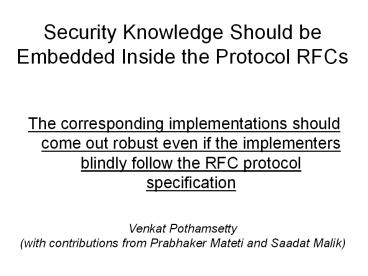Security%20Knowledge%20Should%20be%20Embedded%20Inside%20the%20Protocol%20RFCs PowerPoint PPT Presentation
Title: Security%20Knowledge%20Should%20be%20Embedded%20Inside%20the%20Protocol%20RFCs
1
Security Knowledge Should be Embedded Inside the
Protocol RFCs
- The corresponding implementations should come out
robust even if the implementers blindly follow
the RFC protocol specification
Venkat Pothamsetty(with contributions from
Prabhaker Mateti and Saadat Malik)
2
Why Should Security be Embedded into Protocol
Specifications
- The Types of Security Vulnerabilities have
Remained more or less the Same the Past Few Years - The Attack Techniques (and consequently the Types
of Security Measures) are Limited - Depending on implementers for protection is not
practical - Security Considerations across RFCs are
In-consistent - Security constraints can potentially be embedded
into RFCs with minimal changes to present
policies and procedures
3
The Types of Security Vulnerabilities have
Remained more or less the Same the Past Few Years
- Vulnerabilities arising from not checking packet
content Implementation crashed when it
encountered a packet with zero as the field
content - Vulnerabilities arising from not checking packet
size - crashed when it received
big_sized/small_sized/zero_length packet - Vulnerabilities arising from not limiting the
packet rates - Implementation crashed when it
received a "flood" of packets - Vulnerabilities arising from not limiting the
number of pay load attributes Implementation
crashed when large number of attributes are
received - Vulnerabilities arising from not checking the
packet sequence - Implementation hung when it did
not received a packet late or did not receive a
packet or received a wrong sequence of packet or
multiple copies of a packet - Vulnerabilities arising from interpretation of
terms - Implementation hung when it received an
IP with a 0.0.0.0 address - Vulnerabilities arising from in-correct field
parsing sequence Implementation crashed when a
field was not checked before starting to parse
the rest of the packet - Above information is the result of analyzing
over a 1000 publicly known vulnerabilities from
various sources A Vulnerability Taxonomy for
Internet Protocols, published 2004
4
The Attack Techniques (and consequently the Types
of Security Measures) are Limited
- Malformed Constrain the specification with
pre-post conditions - Flooding Limit the packet rates for each packet
or each state - Spoofing/sniffing Force every specification to
use security techniques (authentication,
confidentiality) - Replay, reuse, out of sequence Force every
state to accept a specific sequence - Ambiguous terms Explain the terms used with
mathematical means - A complete list is published in the paper, A
Case for Attack Intelligent Specifications,
published 2005
5
RFC implementations Need to be Protected from
this well-defined and well-contained Set of
Attacks
- Adopting security measures against this set of
attacks will take care of a large percentage of
security issues we see today
6
Security Considerations across RFCs are
In-consistent
- Security considerations sections do not
consistently - Methodically consider all attack scenarios
- Propose specific solutions to threats identified
- Security consideration sections claim, with out
clear justification, that the RFC brings no
additional threats
7
Embedding Protection within the RFC Protocol
Specifications is the Best Possible Solution
- Depending on implementers for protection is not
practical - Training the protocol developers to write secure
code is hard - The implementation is only as secure as the
implementer - With protection embedded, the implementers can be
made accountable for the security of the
implementation they have to be contractually
obligated to follow the specification. - The solution is scalable there are a lot fewer
specification writers than there are
implementers. - The solution is effective it nips the evil in
the bud, stops the vulnerabilities even if the
application code is not so robust.
8
One (rather extreme) Way of Implementing this
Proposed Solution
- Specification of a RADIUS Server
- do
- wait-for(current-requests, empty-bag, "!")
- object p IP-UDP-packet remove-a-packet(curren
t-requests) - if is-IP-UDP-RADIUS-packet(p)
- and is-Access-Request(p)
- and is-valid-client(p)
- and is-channel-encrypted(p)
- and is-valid-packetrate(packet_history)
- and is-not-duplicate-request(p) --gt
object r IP-UDP-RADIUS-packet
compute-response(p) - send-packet(r)
- servers-past p, r
- fi
- od
9
One (rather extreme) way of Implementing this
Proposed solution(continued)
- Specifying the Structure of a RADIUS Packet
- model RADIUS-packet is composite ( code,
identifier byte, - length short,
- authenticator Authenticator,
- attribute-bytes seq byte,) such that
- for all r RADIUS-packet (
- r.code 1 .. 5, 11 .. 13, 255,
- r.length 20 \attribute-bytes lt 4096,
- r.length lt r.sizeof,
- valid-attribute-bytes(r))
10
Some of the Issues That Still Need to be
Addressed in This Model
- Some of the specifications could be very platform
dependent - But some packets are always malicious packets
- Hard to change the existing culture and processes
of RFC writing - The embedded security constraints could be made
to require minimal changes - The process is not tested thoroughly
- We could start out with a few RFCs..
11
Meyer's Seven Sins of the Specifier
- Noise
- The presence in the text of an element that does
not carry information relevant to any feature of
the problem. Variants redundancy remorse. - Silence
- The existence of a feature of the problem that is
not covered by any element of the text. - Over specification
- The presence in the text of an element that
corresponds not to a feature of the problem but
to features of a possible solution. - Contradiction
- The presence in the text of two or more elements
that define a feature of the system in an
incompatible way. - Ambiguity
- The presence in the text of an element that makes
it possible to interpret a feature of the problem
in at least two different ways. - Forward reference
- The presence in the text of an element that uses
features of the problem not defined until later
in the text. - Wishful thinking
- The presence in the text of an element that
defines a feature of the problem in such a way
that a candidate solution cannot realistically be
validated with respect to this feature.

